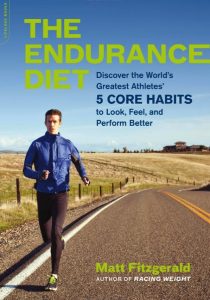MATT FITZGERALD – Runner’s Tribe
Matt Fitzgerald is an acclaimed endurance sports coach, nutritionist, and author. His many books include The Endurance Diet, 80/20 Running, and How Bad Do You Want It?
It is a proven fact that individual pain tolerance predicts endurance performance. Given two athletes with identical physical traits, the one with a higher pain tolerance will likely outperform the other in competition. It is also a proven fact that pain tolerance is trainable. Exposure to pain tends to increase pain tolerance.
 The practical implication of these facts is that, if you want to race to the best of your ability, you need to expose yourself to high levels of suffering in training. There is, in other words, a place for incredibly painful workouts in the endurance training process. But it’s important not to go overboard with this type of training, for three reasons. One is that incredibly painful workouts are very stressful, so if you do them too often you will become overtrained and your fitness will decrease. Also, pain tolerance is only one of many contributors to endurance fitness, and many of the other contributors are best developed through other types of workouts. And finally, it’s hard to get yourself up for intense suffering very often, and dipping into that well too frequently can lead to mental burnout.
The practical implication of these facts is that, if you want to race to the best of your ability, you need to expose yourself to high levels of suffering in training. There is, in other words, a place for incredibly painful workouts in the endurance training process. But it’s important not to go overboard with this type of training, for three reasons. One is that incredibly painful workouts are very stressful, so if you do them too often you will become overtrained and your fitness will decrease. Also, pain tolerance is only one of many contributors to endurance fitness, and many of the other contributors are best developed through other types of workouts. And finally, it’s hard to get yourself up for intense suffering very often, and dipping into that well too frequently can lead to mental burnout.
This is the problem with programs like CrossFit. The ethos of these programs requires participants to give 100 percent in every single workout. This is impossible, and so what most people end up doing is giving about 93 percent in every single workout and forgetting what it’s really like to give 100 percent. If you truly want the benefit of giving a 100 percent effort, you need to do it sparingly.
Endurance athletes are more likely to completely avoid incredibly painful workouts than to overdo them. The typical recreational runner or triathlete is perfectly willing to do really long workouts that become sort of painful near the end in a slow-burn way, but they fear and dodge esophagus-searing intervals done at or near VO2max intensity, cutdown hill repetitions ending at maximum effort, and the like. And when I talk about incredibly painful workouts, that’sthe sort of workout I’m referring to.
To be clear, even most high-intensity workouts shouldn’t be incredibly painful—just moderately painful to painful. Incredibly painful workouts are a special subcategory within the category of high-intensity workouts. It’s also important to keep in mind that the purpose of these sessions is not to destroy your body but to toughen your mind. There’s an infinite variety of incredibly painful workouts you can do, but to serve their intended purpose they must entail a relatively modest amount of total work so that their intensity is not watered down and they don’t destroy your body.
The shortest incredibly painful workout format I know of is the original Tabata. It consists of 10 times 20 seconds at maximum effort with 10-second passive rests between intervals: 200 seconds of pure misery packed into five total minutes. This session is best done on a stationary bike, but if you’re coordinated and daring you can do it on a treadmill set at a steep incline, moving your feet to the edges of the machine for the rest periods and leaping back onto the belt for the sprints.
The single most excruciating incredibly painful workout I’ve ever heard of people actually doing is a session of descending time trials that was once a favorite of the late English manager/coach Kim McDonald. Here’s how to do it: Visit your local running track and warm up thoroughly with at least a mile of easy jogging, dynamic stretches, and accelerations. Then run four laps around the track (1600 meters) as fast as you can. I don’t mean start at a dead sprint and hang on; I mean treat it as a 1600-meter race, where you aim to achieve the lowest finishing time possible. Rest passively as long as necessary to feel ready for more hard running, but no longer. Then run three laps (1200 meters) all-out, rest, run two laps (800 meters) all out, rest, and finish yourself off with a one-lap (400m) time trial.
You wouldn’t believe how fast some of McDonald’s runners were able to run this workout back in the day. Former 5000m American record holder Bob Kennedy, for example, once completed the four time trials in 3:56, 2:55, 1:55, and 54, and his training partner Daniel Komen, who still holds world records at two miles and 3000 meters indoors and outdoors, ran them even faster.
Obviously, you need to be quite fit to attempt such a session. But again, no matter how fit you are, it’s inadvisable to do more than two or three workouts this agonizing in a single training cycle. In my view, the very best time to do an incredibly painful workout is a couple of weeks before your first race in a while, when you are fit enough to really suffer but may have forgotten what it’s like to really suffer.
About the the author – MATT FITZGERALD
Matt Fitzgerald is an acclaimed endurance sports coach, nutritionist, and author. His many books include The Endurance Diet, 80/20 Running, and How Bad Do You Want It? Matt’s writing also appears regularly in magazines and on websites such as Women’s Running and competitor.com. His online training plans have helped thousands of athletes of all experience and ability levels achieve their goals. Certified by the International Society of Sports Nutrition, Matt has consulted for numerous sports nutrition companies and he is the creator of the Diet Quality Score (DQS) smartphone app. A lifelong athlete, he speaks frequently at events throughout the United States and internationally. Matt can be reached at matt@8020endurance.com.
Want a readymade or custom training program from one of the top coaches in the world. Follow this link: http://8020endurance.com/8020-run-plans/
80/20 training plans are provided via TrainingPeaks.com or FinalSurge.com. Both platforms offer comprehensive scheduling, logging, and analysis with outstanding web and mobile applications for all 80/20 plans. Our structured workouts plans, below, represent the latest training technology that makes completing a workout easier than ever. Structured workout run plans measure your intensity by either ![]() Pace,
Pace, ![]() Heart Rate, or
Heart Rate, or ![]() Power.
Power.





























